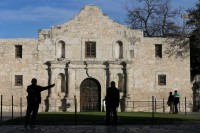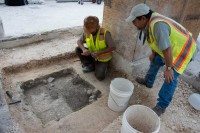 The Alamo Mission of San Antonio, location of an 1836 battle during the Texas Revolution that has attained legendary status and given the site reputation as “the shrine of Texas liberty,” is Texas’ greatest tourist draw, with approximately 2.5 million visitors a year. It isn’t in the greatest condition, however. Many of its walls were torn down and outbuildings burned by the retreating Mexican army when the war ended a few months after the Battle of the Alamo. Later construction, poor moisture control and political conflicts over ownership and restorations have left the complex in need of extensive refurbishing to emphasize its historical features. In conjunction with the 180th anniversary of the famous siege, the Reimagine the Alamo project seeks to effectuate much-needed renovations, repairing rotting wood beams and roof damage, removing eyesores like random storage shacks attached to the historic walls and condenser units and building new visitor and museum facilities.
The Alamo Mission of San Antonio, location of an 1836 battle during the Texas Revolution that has attained legendary status and given the site reputation as “the shrine of Texas liberty,” is Texas’ greatest tourist draw, with approximately 2.5 million visitors a year. It isn’t in the greatest condition, however. Many of its walls were torn down and outbuildings burned by the retreating Mexican army when the war ended a few months after the Battle of the Alamo. Later construction, poor moisture control and political conflicts over ownership and restorations have left the complex in need of extensive refurbishing to emphasize its historical features. In conjunction with the 180th anniversary of the famous siege, the Reimagine the Alamo project seeks to effectuate much-needed renovations, repairing rotting wood beams and roof damage, removing eyesores like random storage shacks attached to the historic walls and condenser units and building new visitor and museum facilities.
As part of the Reimagine project, earlier this month archaeologists began the first systematic archaeological study of all five and a half acres of the Alamo complex. Only the the church and the lower floor of the long barracks of the 1836 fort still stand above ground. The project’s aim is to rediscover the footprint and any remains of the original 18th century Spanish mission, the Mission San Antonio de Valero, and the 19th century fortress, particularly the mission’s western and southern walls. They also hope to find materials from the mission period — ceramics, trash, glass, personal items — and from its military days — weapons, ammunition, household goods. The archaeology is integral to determining where the new facilities will be built and in the accuracy and rigor of the historical interpretation of the Alamo which last year was designated a UNESCO World Heritage site.
 The team started with a geophysical survey of the complex, using ground penetrating radar to narrow down areas of interest. Then they raised the flagstone pavers and began digging. On July 22nd, the excavation team unearthed the remnants of an adobe brick wall 23 inches below the surface. The Spanish colonial adobe bricks were found in what archaeologists believe was the location of the original mission’s west wall.
The team started with a geophysical survey of the complex, using ground penetrating radar to narrow down areas of interest. Then they raised the flagstone pavers and began digging. On July 22nd, the excavation team unearthed the remnants of an adobe brick wall 23 inches below the surface. The Spanish colonial adobe bricks were found in what archaeologists believe was the location of the original mission’s west wall.
Discovery of the bricks on Friday marked a major step toward uncovering the construction history of the world-famous Texas landmark.
“Because we’ve got something from the Spanish colonial period, we know we are digging in the right place,” archaeologist Nesta Anderson said in a press conference Monday. “Now we know we can get information from the ground over here that will support the master plan and the reinterpretation.”
Adobe is very delicate and soft and these bricks have been hard-used by centuries of conflict and the elements. The team is studying the bricks to confirm their Spanish origin, pin down the date of construction and determine the wall’s place in the structure of the 18th century mission. As far as we know, the mission didn’t have a full exterior wall around its perimeter. Instead, the walls of some of the buildings became defacto outside walls. If the adobe bricks were not part of the western wall, they could have been part of another building on the mission grounds or even one of the Native American dwellings that grew up around the mission.
Here’s a short video of an archaeologist pointing out the adobe bricks in the trench.
[youtube=https://youtu.be/DHtJA2-5-W4&w=430]
The excavation is scheduled to last four weeks. For regular updates on the dig, follow Reimagine the Alamo’s Facebook page.